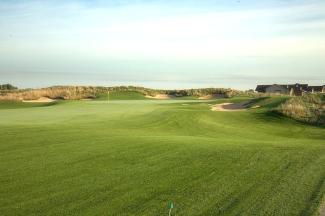Featured Golf News
Green-Backing Mounds
In addition to back-to-front slopes and concave green entries, many golf course architects, including me, often use backing and surrounding mounds, ridges and elevated earth forms to help contain errant shots near, if not on greens.

As a response to current issues of helping average golfers score better (without playing better) and theoretically increasing pace of play, greens surrounded by mounds are common in modern design. Faster and flatter greens often cause low-spin shots to roll out even further, making small backing mounds even more necessary when considering average golfers.
As with any common and possibly overused design feature, there is a small retro trend away from these, in order to make designs visually distinct and/or more challenging for better players.
However, my thought is that backing mounds encourage good players to play more aggressively to back pins, and aggressive play makes golf more fun, so my designs try to favor that. Or, as George Thomas once wrote, a shot that goes slightly over the green is really a better shot than one that comes up short, and theoretically, should not be punished by a non-receptive target area, which a green that falls directly away on the back often is, without other compensating features like slope, green depth, etc.

Early Scottish courses often had only fairway-height slopes (circa 1800's height, not 2000's height of cut!) but they probably formed accidentally, as greens were placed on natural high points for drainage, and there was only one height of cut in those days. However, Golden Age architects often added mounds and shaping of the areas surrounding greens. As more greens were built than "found," most felt that recreating wavy, naturalistic contours was more attractive and tied into nature more than simpler plain slopes.
Architects often tried to mimic some early greens that sat low among towering dunes, even if, as one admitted, most efforts to replicate those natural dunes looked puny in comparison. Even at smaller scale, setting greens low among mounds creates a sense of "enclosure" and "place," which is an underappreciated aspect of landscape design. Trees can define space and act as the visual end to a golf hole, but when full-grown trees are not present mounds provide the backdrop more easily and immediately than immature plantings.
And often, back mounds are used do divert drainage from rolling right to the green surface.
I do fall into the common use of backing mounds, as shown in these photos from Sand Creek Station in Newton, Kansas.
In the top image is the 14th hole, which shows how backing mounds can contain behind
the green bunkers and make them visible, while framing the green.
In the bottom photo is the 17th hole, which demonstrates the value of variety, and shows that with substantial trees, no backdrop mounding is required. In addition, the long horizontal shrub row is actually on a railroad mainline. I used this opportunity to mimic the famous Road Hole green at the Old Course, which of course, fell straight away to the old tracks. This is a huge green on a short par-5, and a good opportunity to have a green fall steeply right off the back, Most players approach it with very short irons, and the longer shots, attempting to reach the green in two, should be more challenging.
Jeffrey D. Brauer began his career as an apprentice in the Chicago area in 1977. His first project was Kemper Lakes, which shortly after hosted the 1989 PGA Championship. He formed GolfScapes in Arlington, Texas, in 1984. In the last 29 years he has designed and consulted on a wide spectrum of projects, ranging from partial renovations to international resorts. His recent work includes teaming with the design team of Pascuzzo and Pate on a remodel of the world-famous La Costa Resort & Spa in California, and renovations at Superior National Golf Course in Lutsen, Minn., and Mesquite Municipal Golf Course in Mesquite, Texas.
He has been a member of the American Society of Golf Course Architects since 1981, serving as President during its 50th Anniversary year in 1995-96. Jeff still studies the classic works - both old and new, and has played more than 75 of the best courses in the world.
Jeff gives many presentations and is a regular architecture columnist for many publications and websites, including Golf Course Industry and Cybergolf.com. He has also been a strong advocate for the "Tee it Forward" campaign and strives to make his courses fit the description of "fun to play every day."
Jeff's work has been spotlighted in most of the world's major golf magazines. Golf World ranked him as one of the top-20 golf course architects and Golf Inc. ranked him as the world's fourth-best value in golf architecture in 2010. Jeff's portfolio and reputation keep him at the forefront of desired designers for new courses, reconstruction and renovation projects. For more about Jeff, visit http://www.jeffreydbrauer.com/sites/courses/layout.asp?id=859&page=48451.
Story Options
 |
Print this Story |
